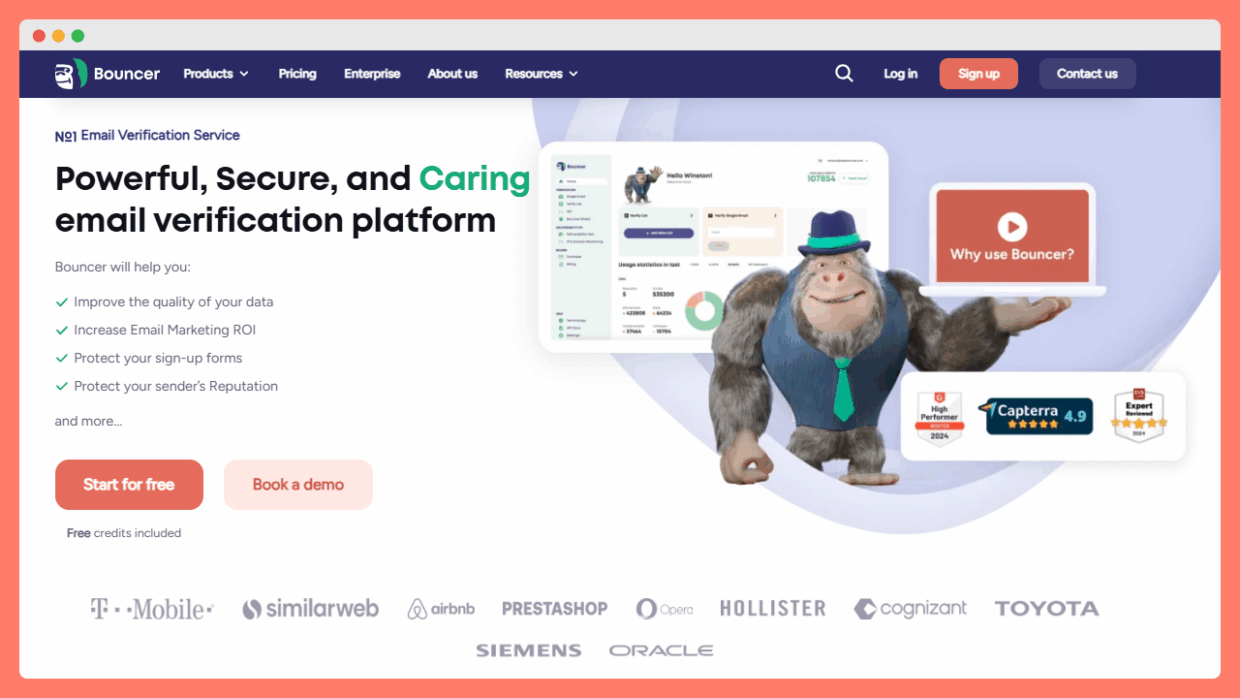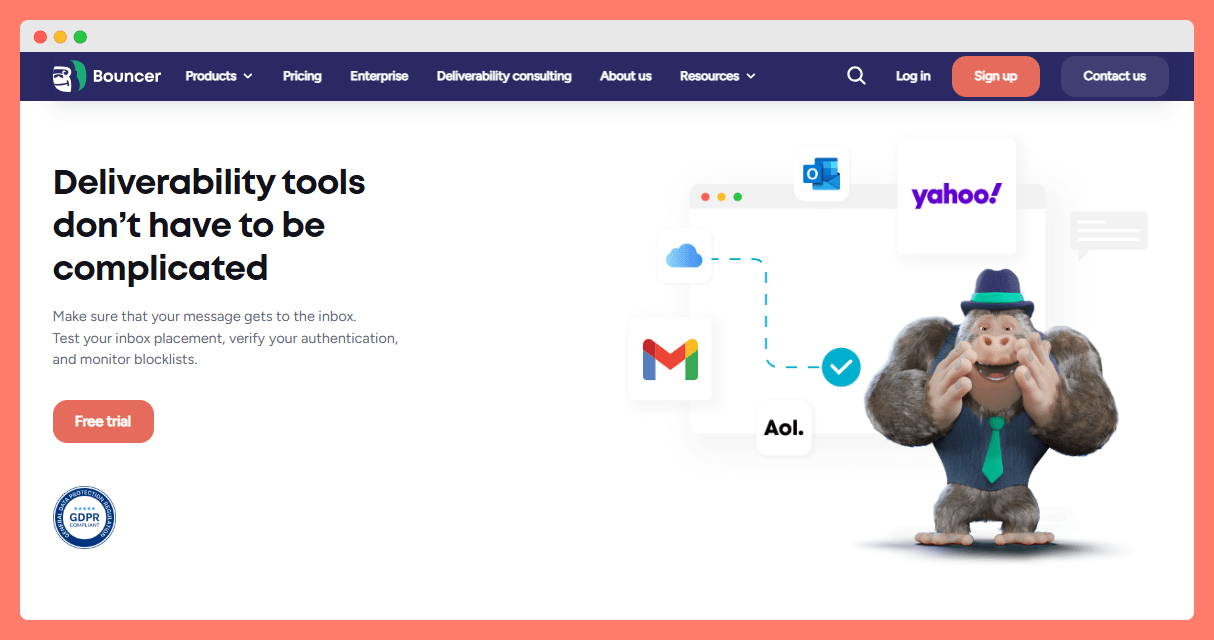But there’s a simple step you can do: verify email address before sending.
Think it’s too basic to matter? Far from it. It still can transform your results, protect your reputation, and ensure your message actually reaches the intended recipient.
Stay with us and learn all the essentials.
What does it mean to verify email addresses?
To verify email addresses means to double-check each address on your list before pressing send. A proper email verifier will confirm the address exists, the mailbox is valid, and the domain is ready to accept emails.
With just a few clicks, the right tools run syntax validation, domain validation, and even connect with the recipient’s mail server to get accurate results. The process might sound technical, but it boils down to this: you want to make sure the email address belongs to a real user who can actually receive your message.
The mechanics: How does email verification work?
Let’s break down how modern email verification tools work behind the scenes.
First comes syntax validation, which ensures the address follows the correct format (no typos or misplaced characters).
Next, the email checker pings DNS records to verify that the domain exists and has an MX record that can accept emails.
The tool then attempts to connect with the mail server using a TCP connection. Sometimes, even using commands like VRFY or EXPN to check if the mailbox can receive emails.
If the server responds positively, you know you have a valid mailbox.
Advanced email verifiers can also detect disposable email addresses, flag full mailboxes, and filter out spam traps. All this happens in seconds, ensuring you only send email messages to addresses that will actually be delivered.

Why should you validate email addresses before you send?
Oh, there are many reasons for that.
Reduce bounce rates
When you send email messages to invalid addresses, you increase bounce rates – hurting your sender reputation with every failed delivery. Verifying addresses ahead of time keeps your bounce rates low and your email list healthy.
Protect your sender reputation
Email providers like Gmail, Yahoo, and others track sender reputation. Too many bounces, spam complaints, or attempts to send to invalid mailboxes? Your future campaigns might land in spam folders or never reach inboxes at all.
Avoid spam complaints and blacklists
Sending emails to spam traps, or repeatedly messaging unengaged users, is a fast track to blacklists. Verifying addresses, detecting disposable or fake emails, and removing invalid addresses keep your campaigns compliant and effective.
Improve deliverability and engagement
Every verified, valid address increases your odds of connecting with the intended recipient. When your list is clean, your message lands in more real inboxes, and you see better open rates, clicks, and conversions.
Save time and money
Why pay to send email to addresses that bounce or don’t exist? Cleaning your email list means you only pay for real opportunities. Plus, you save your team from troubleshooting delivery issues or handling unnecessary data.
Keep your database accurate
Over time, users change jobs, update accounts, or abandon inboxes. Ongoing email validation helps you keep your database current, ensuring every contact is still valid.
What happens if you skip email verification?
Shortly speaking: skipping email validation exposes you to a host of problems:
- Higher bounce rates and failed deliveries
- Wasted resources sending to undeliverable emails
- Poor sender reputation, impacting all future campaigns
- Greater risk of spam complaints and blacklists
- Lower ROI on every email campaign
Ultimately, you lose access to users who would have received your message if you had just taken the time to verify.
How does an email verification API help?
For companies and developers, an email verification API can be integrated directly into signup forms, CRM systems, or even tools like Google Sheets. This allows for real-time validation as users enter their addresses.
The API checks the syntax, domain, MX record, and mail server response instantly. As a result, it helps remove invalid addresses before they ever make it onto your email list. It’s a must-have for growing businesses that want to automate and scale their verification process.
What should you look for in an email checker or validation tool?
- Syntax and domain validation: Check that each address and domain follows industry standards.
- MX record and server checks: Confirm that the mail server is online and accepting messages.
- Detection of disposable email addresses: Block throwaway or temporary addresses.
- Ability to verify lists in bulk: For growing email campaigns, bulk validation is essential.
- Real-time verification API: Integrate with your website or CRM for instant results.
- Detailed response codes: The best tools explain why an address failed, not just that it failed.
How do companies use verification in real campaigns?
Most companies start by uploading their full mailbox or address list to an email checker. Within minutes, they get accurate results, showing which addresses are valid, invalid, or risky.
The process is often as simple as just a few clicks.
Larger businesses integrate an email verification API to catch invalid addresses at signup or in their internal systems. When using QR codes to capture user data in forms or campaigns, make sure the QR code size is optimized for easy scanning across devices. This ensures smooth data capture without frustrating users. Even non-technical teams can take advantage.
Even non-technical teams can take advantage. There are website-based tools and plugins that work with Google Sheets, CRMs, and popular email marketing platforms, like Bouncer.
Bouncer is the go-to tool for email address verification

Bouncer stands out for its ability to confirm that an email address exists before you ever hit send.
Using advanced methods, Bouncer checks not just the syntax and domain, but also connects with the recipient’s SMTP server to verify the real status of every address.
Moreover, the system securely interacts with email servers using techniques like the VRFY command and checks the response from the server, all without actually sending a verification email. This process is quick, discreet, and helps avoid unnecessary messages that could impact your sender’s reputation.
What does that mean for you? Better email deliverability.
By filtering out risky or invalid contacts before your campaign goes live, Bouncer keeps bounce rates low and improves inbox placement. In practice, this gives your emails a much better chance of landing right in the recipient’s inbox.
Need further assistance? So take advantage of our Deliverability KIt!

For any business that cares about successful campaigns and flawless email deliverability, Bouncer offers peace of mind with every send.
The bottom line? Double-check before you send!
To verify email address before sending is the foundation of good email marketing.
It means your data stays accurate, your sender reputation stays strong, and your email campaigns actually reach the intended recipient.
Don’t wait for a wave of bounce backs, spam complaints, or warning emails from your provider. Invest in a trusted email verifier, make validation part of your routine, and keep your communications sharp, effective, and welcome in every inbox.

Email verification FAQs
Does email verification guarantee delivery?
No tool can guarantee every message is delivered, but proper validation will reduce bounce rates and catch invalid addresses before you hit send.
How often should I validate my email list?
Regularly! At least every quarter, or before major campaigns, and always after importing new addresses.
Will verification tools work with Gmail, Yahoo, or company domains?
Yes, good tools check addresses across all major providers and custom domains, provided the server allows verification.
What is an email verifier and why do I need it?
An email verifier is a tool that checks whether an email address is valid, active, and able to receive messages. Using an email verifier before sending campaigns helps you avoid bounce backs, maintain a clean contact database, and protect your sender reputation.
How does domain validation impact email marketing success?
Domain validation ensures that the domain of each email address on your list is real and able to accept emails. By filtering out addresses with invalid or expired domains, you reduce failed deliveries and improve the overall effectiveness of your campaigns.
What is the difference between email validation and simple email checks?
Email validation goes beyond checking format—it confirms that the address exists, the domain is valid, and the mailbox can receive emails. Simple checks may catch typos, but email validation provides accurate, actionable results to keep your list clean and engaged.
Why is email deliverability important for businesses?
Email deliverability measures the percentage of your emails that actually reach the recipient’s inbox rather than the spam folder. High deliverability is essential for engagement, conversions, and a strong sender reputation, making it a critical focus for all serious email marketers.
Can I verify email addresses stored in Google Sheets?
Yes, many modern email verification tools integrate directly with Google Sheets, allowing you to validate email addresses within your spreadsheets in just a few clicks. This makes list management and cleanup fast, easy, and accurate.
How often should I clean my email list?
It’s smart to clean your email list regularly—at least once a quarter, or before any major campaign. Regular validation helps remove inactive or invalid contacts, reduces bounce rates, and ensures your messages are always reaching real people.

